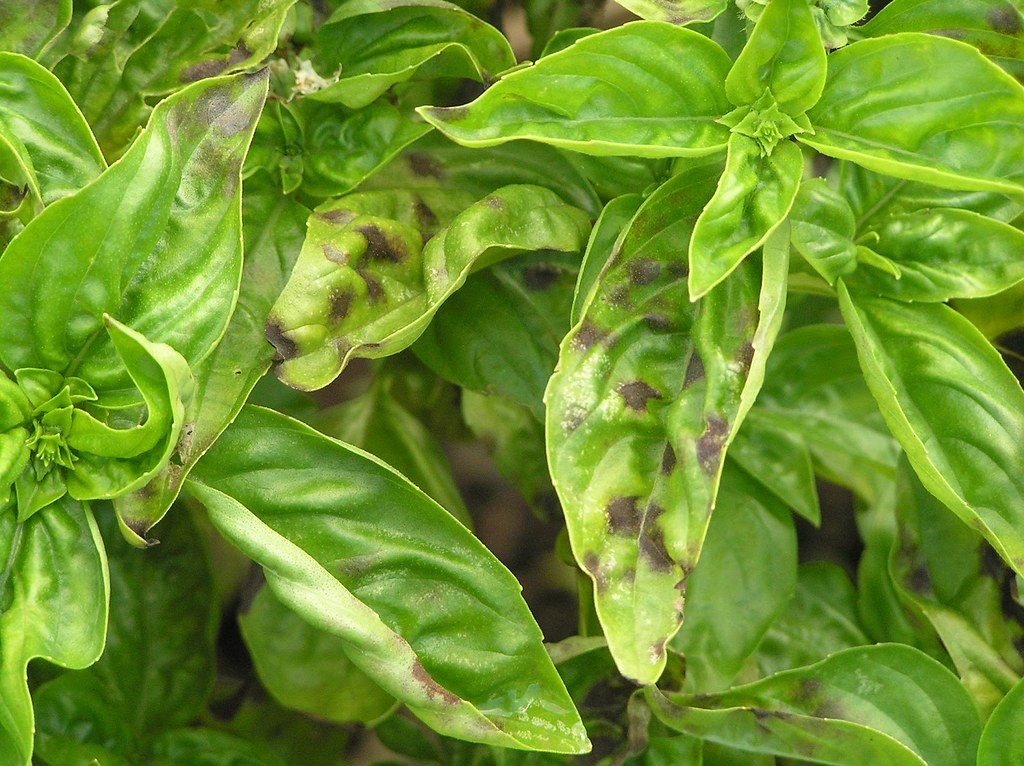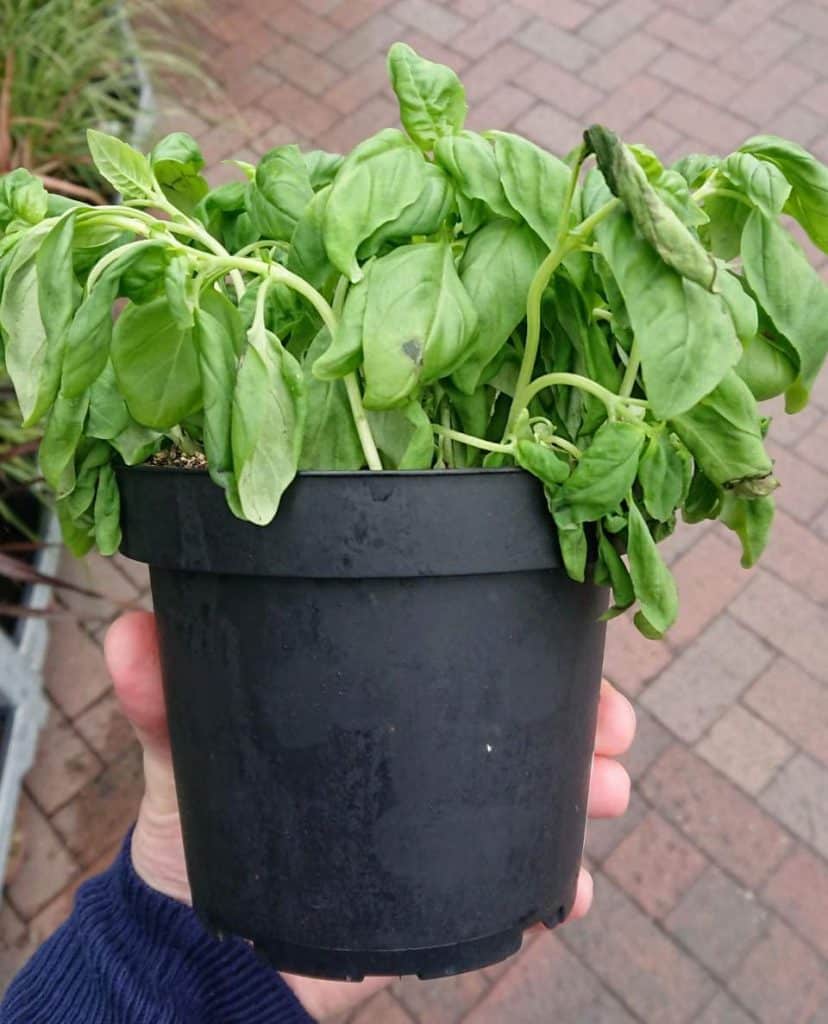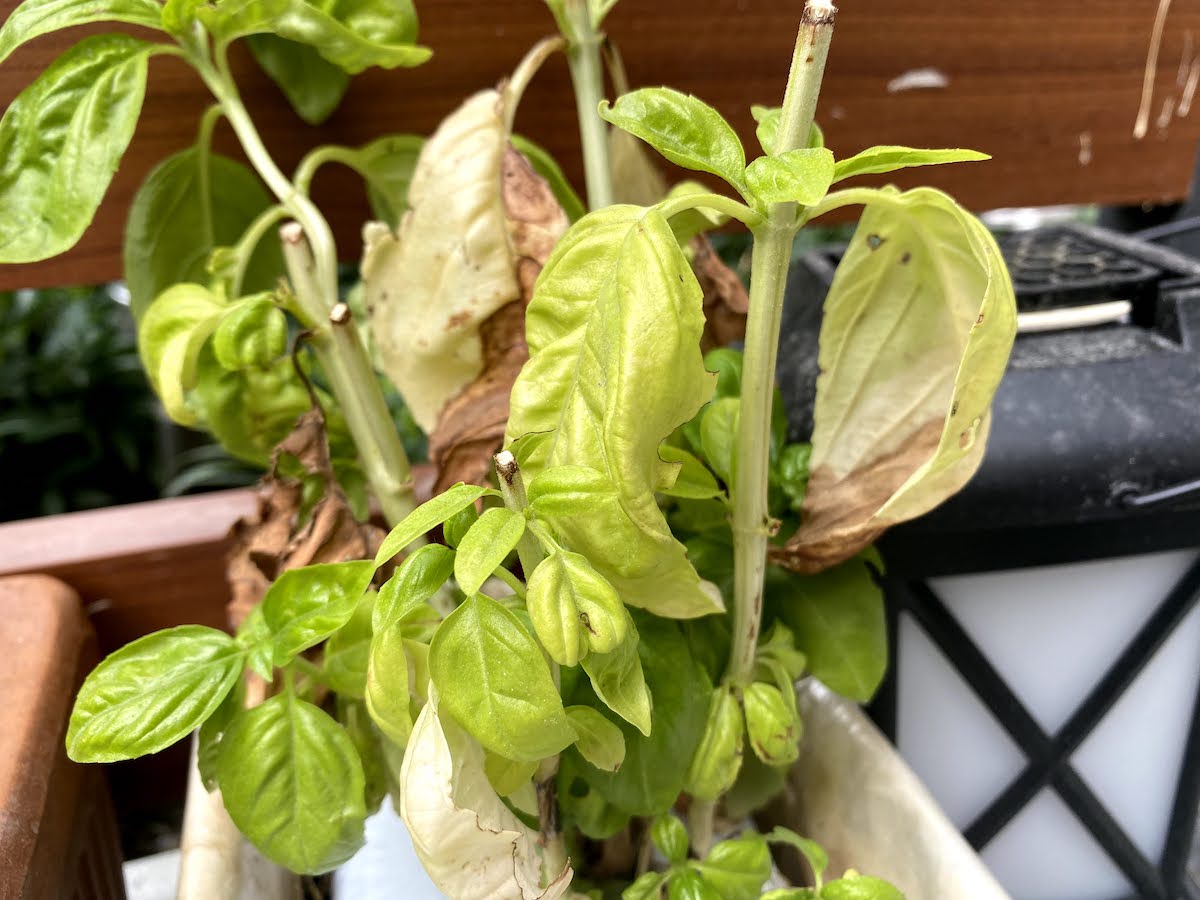Basil leaves that go brown, wilt, and die are caused by dry soil that results from underwatering, too much sun, wind, high temperatures, or small pots that dry out too rapidly. Basil requires perpetually damp soil. The basil wilts to conserve moisture if the soil dries out and frequently turns brown and appears to be dying.
Overwatering or a lack of nutrients in the soil can cause basil plants to turn yellow. Usually, this happens because the pot is too tiny and there is not enough compost available for the basil’s roots to absorb nutrients from.
Most frequently, a lack of pruning is to blame if the basil is drooping. To stimulate additional leaves and avoid a droopy appearance, basil should be kept at a height of 6 to 8 inches.
An appearance of basil that is drooping or wilting can also be caused by insufficient sunlight, excessive fertilizer, and overwatering.
It is crucial to recreate the conditions that a dying basil plant prefers, including six hours of morning sunlight, constantly moist soil, and planting basil in a large pot so that the roots can obtain the necessary nutrients and to protect basil from the hot afternoon sun.
Basil is an annual herb (keep in mind that it grows in the spring and summer, then sets seed and dies back in the winter).
If your basil plant is withering, going brown, turning yellow, or drooping, keep reading to learn how to save it.
Table of Contents
Basil leaves Wilting, Turning Brown and Dying
- Symptoms. Basil plants are often becoming brown or yellow as they wilt and droop.
- Causes. High temperatures, too much sun, too much wind, overwatering, underwatering, a pot that is too tiny and dries out too quickly, and so on.
When it’s hot outside, basil plants typically don’t get watered frequently enough, and their pots are too small. The soil must be uniformly moist for basil to grow. Basil’s leaves and stems might wilt in hot weather because the soil can dry out before the plant’s roots can take in moisture.
Basil is able to thrive in constantly damp yet well-draining soil. With porous, friable compost and frequent watering, especially in the summer, it is possible to attain this balance of continuous moisture while still having well-draining soil.
Due to its proportionately large leaves and herbaceous stems (rather than woody stems), which can lose a lot of moisture, basil wilts quite fast if the soil dries out for any length of time.
By drying out the soil and increasing transpiration from the leaves and causing them to become brown and look to be withering, too much wind and sun can significantly worsen water loss.
Although basil may thrive in full light, it prefers morning sun followed by shade in the midday and late afternoon to avoid scorching temperatures during the hottest seasons of the year.
In high temperatures, basil also briefly wilts, especially if there is an abrupt and large rise in temperature.
Because wilting reduces the surface area of the basil leaf, it efficiently lowers water loss and retains moisture, which is why basil wilts in hot temperatures.
Later in the day, when the temperatures have cooled, the basil frequently comes back to life.
Basil wilting can also be caused by having too-small pots.
Smaller pots can hold less soil, which means they can hold less moisture. The basil wilts in hot weather because the smaller pot dries up much more quickly.
How to Revive a Wilting Basil Plant and Basil with Brown Leaves
Maintaining constant moisture in the soil, placing the basil in a place that receives morning sun and afternoon shade, and protecting the basil from strong winds are the keys to saving a wilting basil plant. The wilting basil should come back to life after a thorough bath.
- Make sure to soak the basil thoroughly so that any extra water drips out the bottom of the saucepan. This makes certain that the soil is consistently moist and that the water has gotten to the basil roots where it is needed. Giving the basil plenty of water also encourages root development, which boosts the plant’s toughness.
- Basil needs to be watered as often as necessary to keep the soil continuously moist. The weather will determine how frequently you water basil. If basil is grown in a large pot, it usually only needs a good soak once a week, but during the hottest months of the year, it may be required to water basil every one to three days. Use your finger to test the soil to see how rapidly it is drying out, then water the area accordingly.
- In a pot of adequate size, plant basil. If the pot is too tiny, it might not matter how frequently you water basil to keep it from wilting. Small pots can hold less soil, which means they can hold less moisture. Smaller pots may dry up on hot, sunny days before the basil’s roots have a chance to draw in water, which will cause it to wilt. Basil should ideally be planted in a clay, ceramic, or terracotta pot that is at least 10 inches across so that there is sufficient soil and moisture to keep the basil from wilting.
- Basil should be grown in the morning sun and then moved to shade in the afternoon to prevent wilting. Basil may appreciate the sunshine while it’s still colder in the morning. Find a cool place in the afternoon because temperatures tend to peak after noon, allowing your basil to recuperate from withering.
- Keep strong winds away from the withering basil. Wind dries out pots and drains moisture from leaves, which can turn them brown and crunchy. Basil benefits from some airflow since it lowers the chance of fungus, but keep it out of the direct sun while it heals.
- Brown leaves should be removed. When plants are under drought stress, their leaves frequently wilt and turn brown. With a sharp pair of pruners, cut these brown leaves back to healthy growth because they don’t recover and aren’t suitable for consumption. Pruning back encourages new growth and stops basil from bolting (flowering and turning to seed). The basil should live if you prune it back to a height of around 6 to 8 inches if you take good care of it.
Your basil plant has all it needs to recover thanks to early sun and afternoon shade, constantly moist soil, a spacious pot, and routine pruning.
Read my article on how frequently to water basil plants to find out more about how to water basil plants based on the weather.
Keep in mind that basil plants are “annuals,” which means they develop from seed and die back within the same season. As a result, if your basil is wilting and turning brown at the end of the year, this is not necessarily a sign of issues with care or culture.
(Read my article Why is my basil flowering for more information on this and how to stop flowering so that basil continues to produce tasty leaves.)
Basil Leaves Turning Yellow
- Symptoms. Growing brown patches and becoming yellow, basil plants. Basil might also appear to be sagging.
- Causes. Overwatering, nutrient-poor soil, pots lacking drainage holes, slow-draining soil, slow-draining pots, and small-diameter pots are all problems.
Overwatering and poorly draining soils are the main causes of basil turning yellow. Basil requires soil that is regularly moist but also has good drainage. Basil leaves become yellow and droop as a result of a lack of oxygen around the roots if the soil is wet or saturated from overwatering.
While basil demands regularly moist soil, it also needs good drainage to prevent the soil from becoming soggy around the roots.
The presence of too much water surrounding the roots inhibits oxygen from reaching the soil, which interferes with the roots’ ability to absorb moisture and nutrients and prevents them from breathing. The leaves turn yellow as an indication of stress if the roots are unable to absorb moisture or nutrients.
Bogging soil also encourages the development of fungal diseases such Fusarium wilt and root rot, which cause basil leaves to turn yellow, brown, or black and look to be dying.
If you are growing basil indoors, planting it in pots without drainage holes or using saucers and trays underneath basil plants can also result in soggy soil and yellowing leaves.
Basil can also turn yellow when grown in a little pot or in soil deficient in nutrients. Basil’s leaves will fade and droop if the container is too tiny since there won’t be as much compost for the roots to absorb nutrients from.
How to Revive Basil with Yellow Leaves
The basil has a decent chance of recovering in the coming weeks if the leaves are turning yellow because of small pots and a lack of nutrients.
Cut back any yellow leaves after new growth appears since they have a diminished flavor and frequently a bitter taste.
It can be considerably harder to revive basil leaves if the soil is moist and the leaves are going yellow.
However, if you make sure that the basil has good compost that drains properly and that water can readily drain from the base of the pot, the basil may begin to recover.
I advise planting extra basil seeds if it is still reasonably early in the growing season (preferably June at the latest), since they germinate quickly and you can have new, prolific basil in (if conditions are good) around 4 weeks (basil typically germinates in 5-10 days).
Basil Plant Drooping
- Symptoms. Basil lacks a compact, bushy appearance and might become lanky and sparsely covered in leaves.
- Causes. Basil droops at the conclusion of the growing season due to irregular pruning, excessive fertilizer use, and insufficient sunlight.
Basil droops most frequently because it is not clipped frequently enough. To avoid drooping and maintain a healthy, productive plant, basil should be clipped every two weeks to a height of 6 to 8 inches. Insufficient sunlight and excessive fertilizer can also cause basil to droop.
To keep the plant compact, bushy, and more prolific, basil should be kept to a height of 6 to 8 inches.
Compared to basil that is allowed to grow higher than 8 inches, which eventually becomes drooping from its own weight, a basil plant that is periodically clipped yields more leaves.
As annual plants that only exist for the Spring and Summer before producing seeds and withering back in the Fall or Winter, basil also has a drooping aspect at the conclusion of the growth season.
For a supply of fresh basil over the winter, it is a good idea to freeze your collected basil leaves at the end of the season.
Basil also prefers a lot of sun, preferably 6 hours in the morning, followed by 3 hours in shade (to prevent the basil form wilting due to high temperatures at the hottest times of year).
Insufficient light causes the basil to grow leggy, produce fewer leaves, turn yellow, and droop downward as it becomes weaker and searches for more light.
Additionally, too much fertilizer encourages droopy, excessive growth. The leaves flourish when there is too much nitrogen in the soil from fertilizer, but the essential oils that give basil its flavor and aroma are less concentrated.
Additionally, the resulting growth is drooping and more vulnerable to pest damage.
How to Revive Drooping Basil
- During the height of the growth season, prune basil every two to three weeks to a height of 6 to 8 inches. Basil grows more leaves and becomes a more robust plant that doesn’t droop under its own weight when it is regularly pruned to the proper height. When growing circumstances are poor due to cloudy days or chilly weather, pruning basil once every four weeks is typically enough to keep the plant from drooping.
Here is a good YouTube video showing how to prune basil to ensure plant health and maximize flavor.
- If you notice basil blooms budging, cut them back right away (If you are growing basil for culinary purposes). Once basil has flowered, it stops generating leaves and the flavor of the leaves becomes less intense as the basil starts to generate seeds. As an annual plant, the basil has successfully reproduced if it has flowered and produced seeds, at which time it begins to droop and look dead. Regular pruning prevents the plant from drooping before flowering and promotes the growth of more leaves for a longer growing season. After the basil plant has blossomed, the leaves frequently taste harsh.
- Basil should be placed in the morning sun for six hours to prevent wilting. When basil receives this much direct sunlight, it is at its most productive and the stems don’t needlessly sag in quest of additional light. The basil is protected from excessive heat during the height of the day and the hottest part of the afternoon by shade, which also helps to maintain the soil’s ideal moisture level. Basil can frequently withstand midday and afternoon sun for the majority of the growing season in milder locations, though I would still advise offering afternoon shade if the temperature suddenly rises dramatically.
- Reduce the amount of fertilizer you use. Basil grows well in healthy compost and doesn’t necessarily need additional fertilizer as this runs the danger of weak stems and lessens flavor by reducing the concentration of essential oils. It can be challenging to restore the drooping aspect once too much fertilizer has been used, but I would advise cutting the basil back to 6 inches, which should assist spur some new growth and aid in its recovery.
- Basil is a perennial plant that, at the end of its growing season, droops and appears to be dying. When basil reaches the conclusion of its one-year life cycle, it gradually turns brown and droops, giving the appearance that it is dying. Basil plants can produce till the beginning of the fall depending on your environment if they are periodically clipped.
Key Takeaways:
FAQ
Does basil come back to life?
It won’t recover from the winter freeze in the spring. It won’t start to grow again from the roots. Basil can only be grown outside year round in warm locations where temperatures do not drop below freezing since basil plants cannot survive the winter.
Will basil survive winter?
Typically, it dies down and the hard seeds wait in the ground over the winter before germination occurs during the spring thaw. This is how most of its growth cycles work. Basil experiences cold damage relatively immediately as the temperature drops, manifesting as blackened leaves. Basil and cold temperatures therefore do not disagree.
How do you revive basil?
A big bowl should be filled with ice and cold water. After removing any damaged or charred leaves, place the entire bundle of wilted herbs in the ice bath. The herbs will be revived by the cold water. It might take about 15 minutes or up to an hour, depending on the herb and how wilted it is.
Why is my basil wilting and dying?
Basil plants can wilt due to either too dry or too damp soil. Basil plants benefit from full sun, but they also require continuously moist, premium soil with good drainage. Check the soil and rethink your basil watering schedule if your plant is withering or drooping.
What does Overwatered basil look like?
The first indication that basil has received too much water is when the leaves begin to yellow or become brown. Additionally, the basil plant will begin to wilt, and if it has received excessive water for a lengthy period of time, the roots will start to rot and smell moldy.



